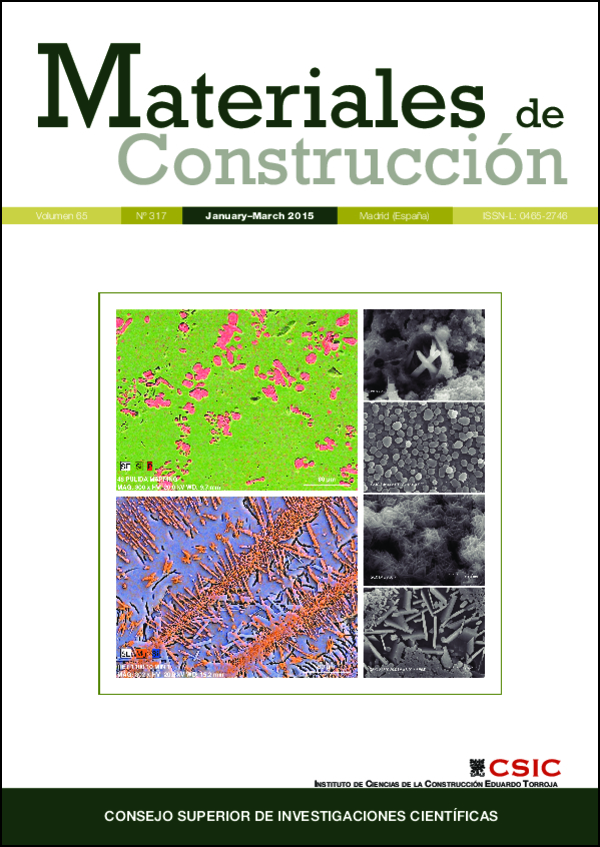Early and late hydration of supersulphated cements of blast furnace slag with fluorgypsum
DOI:
https://doi.org/10.3989/mc.2015.06013Keywords:
Supersulphated, C-S-H, Ettringite, hydration, microstructuresAbstract
The hydration, strength development and composition of hydration products of supersulphated cements were characterized from the first 48 hours up to 360 days. Two compositions of 80% Blast furnace slag, 10–15% Fluorgypsum and 10–5% Portland cement were cured in dry and wet conditions. The main hydration products were ettringite and C-S-H since the first hours and up to 360 days as evidenced by X-ray diffraction, thermal analysis and electron microscopy. The strength was favored by higher fluorgypsum contents and lower Portland cement contents. These cements generated heats of hydration of 40–57 KJ/Kg after 28 hours, which are lower than portland cement.
Downloads
References
1. Escalante García, J.I. (2002) Alternative materials to Portland cement (in Spanish). Avance y perspectiva. 21, 79–88.
2. Gartner, E. (2004) Industrially interesting approaches to "low-CO2" cements. Cem Concr Res. 34, 1489–98. http://dx.doi.org/10.1016/j.cemconres.2004.01.021
3. Mehrotra, V.P.; Sai, A.S.R.; Kapur, P.C. (1982) Plaster of Paris Activated Supersulphated Slag Cement. Cem Concr Res. 12, 463–473. http://dx.doi.org/10.1016/0008-8846(82)90061-8
4. Taylor, H.F.W. (1997) Cement Chemistry, Academic Press, Inc New York.
5. Gruskovnjak, A.; Lothenbach, B.; Winnefeld, F.; Figi, R.; Ko, S.C.; Adler, M.; Mäder, U. (2008) Hydration mechanisms of super sulphated slag cement. Cem Concr Res. 38, 983–992. http://dx.doi.org/10.1016/j.cemconres.2008.03.004
6. Fernández Jiménez, A.; Puertas, F.; Fernández Carrasco, L. (1996) Alkaline-sulphate activation processes of a spanish blast furnace slag. Mater. Construcc. 46 [241], 23–37.
7. Ko, S.C. (2002) Alcali activated supersulphated blinder. United States Patent. Patent N°: US 6,409,819 B1.
8. Hewlett, P.C. (2004) Leaś Chemistry of Cement and Concrete, Elsevier Science & Technology Books Publishing.
9. Midgley, H.G.; Pettifer, K. (1971) The micro structure of hydrated super sulphated cement. Cem Concr Res. 1, 101–104. http://dx.doi.org/10.1016/0008-8846(71)90086-X
10. Bijen, J.; Niël, E. (1981) Supersulphated cement from blastfurnace slag and chemical gypsum available in the Netherlands and neighbouring countries. Cem Concr Res. 11, 307–322. http://dx.doi.org/10.1016/0008-8846(81)90104-6
11. Erden, E.; Ölmez, H. (1993) The mechanical properties of supersulphated cement containing phosphogypsum. Cem Concr Res. 23, 115–121. http://dx.doi.org/10.1016/0008-8846(93)90141-U
12. O´Rourke, B.; McNally, C.; Richardson, M.G. (2009) Development of calcium sulfate-ggbs-Portland cement binders. Constr and Build Mat. 23, 340–346. http://dx.doi.org/10.1016/j.conbuildmat.2007.11.016
13. Kondo, R.; Daimon, M.; Song, C.; Jinawath, S. (1980) Effect of lime on the hydration of super-sulfated slag cement. American Ceramic Society Bulletin. 59 [8], 848–851.
14. Norma ASTM C309-94. Standard practice for mechanical mixing of hydraulic cement pastes and mortars of plastic consistency.
15. Escalante García, J.I.; Sharp, J.H. (2000) The effect of temperature on the early hydration of Portland cement and blended cements. Adv Cement Res. 12 [3], 121–130. http://dx.doi.org/10.1680/adcr.2000.12.3.121
16. Magallanes Rivera, R.X.; Escalante García, J.I.; Gorokovsky, A. (2009) Hydration reactions and microstructural characteristics of hemihydrate with citric and malic acid. Constr Build Mat. 23, 1298–1305. http://dx.doi.org/10.1016/j.conbuildmat.2008.07.022
17. Shi, C.; Day, R.L. (1996) Some factors affecting early hydration of alkali-slag cements. Cem Concr Res. 26 [3], 439–447. http://dx.doi.org/10.1016/S0008-8846(96)85031-9
18. Matscei, T.; Lothenbach, B.; Glasser, P.F. (2007) Thermodynamics properties of Portland cement hydrates in the system CaO-Al2O3-SiO2-CaSO4-CaCO3-H20. Cem Concr Res. 37, 1379–1410. http://dx.doi.org/10.1016/j.cemconres.2007.06.002
19. Martínez Aguilar, O.A.; Castro Borges, P.; Escalante García, J.I. (2010) Hydraulic binders of fluorgypsum-portland and blast furnace slag, stability and mechanical properties. Constr Build Mat. 24, 631–639. http://dx.doi.org/10.1016/j.conbuildmat.2009.11.006
20. Escalante García, J.I.; F. Fuentes, A.; Gorokhovsky, A.; Fraire Luna, P.E.; Mendoza Suarez, G. (2003) Hydration products and reactivity of blast-furnace slag activated by various alkalis. J. Am. Ceram Soc. 86 [12], 2148–2153. http://dx.doi.org/10.1111/j.1151-2916.2003.tb03623.x
21. Matschei, T.; Bellmann, F.; Stark, J. (2000) Hydration behavior of sulphate-activated slag cements. Adv. Cem. Res. 18 [5], 167–178.
22. Odler, I. (2000) Special Inorganic Cements, E & FN Spon.
23. Gomez Zamorano, L.Y. (2004) Geothermal waste as a replacement material of portland cement pastes. PhD Thesis, Metallurgical and Ceramic Engineering. Cinvestav Unidad Saltillo, Mexico.
24. Escalante Garcia, J.I.; Sharp, J.H. (2004) The chemical composition and microstructure of hydration products in blended cements. Cem Concr Comp. 26, 967–976. http://dx.doi.org/10.1016/j.cemconcomp.2004.02.036
25. Shi, C.; Fernández Jiménez, A.; Palomo, A. (2011) New cements for the 21st century: The pursuit of an alternative to Portland cement. Cem Concr Res. 41, 750–763. http://dx.doi.org/10.1016/j.cemconres.2011.03.016
26. Escalante García, J.I.; Sharp J.H. (1999) Variation in the composition of C-S-H gel in Portland cement pastes cured at various temperatures. J. Am. Ceram. Soc. 82 [11], 3237–3241. http://dx.doi.org/10.1111/j.1151-2916.1999.tb02230.x
Published
How to Cite
Issue
Section
License
Copyright (c) 2015 Consejo Superior de Investigaciones Científicas (CSIC)

This work is licensed under a Creative Commons Attribution 4.0 International License.
© CSIC. Manuscripts published in both the print and online versions of this journal are the property of the Consejo Superior de Investigaciones Científicas, and quoting this source is a requirement for any partial or full reproduction.
All contents of this electronic edition, except where otherwise noted, are distributed under a Creative Commons Attribution 4.0 International (CC BY 4.0) licence. You may read the basic information and the legal text of the licence. The indication of the CC BY 4.0 licence must be expressly stated in this way when necessary.
Self-archiving in repositories, personal webpages or similar, of any version other than the final version of the work produced by the publisher, is not allowed.
















